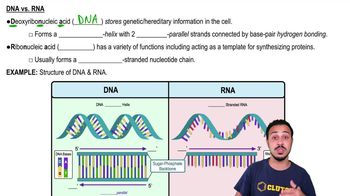Here are the essential concepts you must grasp in order to answer the question correctly.
Transcription Process
Transcription is the biological process where the information in a gene's DNA is copied into messenger RNA (mRNA). This process occurs in the nucleus of eukaryotic cells and is essential for gene expression, allowing the genetic code to be translated into proteins.
Recommended video:
1) Initiation of Transcription
RNA Synthesis
During transcription, RNA polymerase synthesizes a single strand of RNA by pairing complementary RNA nucleotides with the DNA template strand. This results in the formation of an RNA copy of the gene, which can then be translated into a protein.
Recommended video:
Base Pairing Rules
In transcription, the base pairing rules dictate that adenine (A) in the DNA pairs with uracil (U) in RNA, while cytosine (C) pairs with guanine (G). This is crucial for ensuring the accurate transfer of genetic information from DNA to RNA.
Recommended video:
 Verified step by step guidance
Verified step by step guidance



 5:51m
5:51m